
The Palazzo Vecchio de' Medici, also called the Palazzo della Prefettura is a Gothic revival-style palace located on Piazza Giuseppe Mazzini #7, in the city of Pisa, region of Tuscany, Italy.

The Palazzo Vecchio de' Medici, also called the Palazzo della Prefettura is a Gothic revival-style palace located on Piazza Giuseppe Mazzini #7, in the city of Pisa, region of Tuscany, Italy.

The palace was erected at the site of a house with a tower, built in the 11th century by the aristocratic Albizone (or Albitone) family.
The palace was the residence in 1539, of Cosimo I de’ Medici, and further refurbished by Eleonora of Toledo. In 1574 Francesco I de' Medici erected a new Medici Palace (Palazzo Reale) in town, and by 1784, this Palace became property of Jacopo Finocchietti.
The present façade was commissioned by Marchesa Vittoria Spinola (Morganatic daughter of Victor Emmanuel II), per the designs of Ranieri Simonelli. This architect replaced the façade windows of the first and second floor with gothic mullioned windows, and erected a tower with merlons (1879).
The palace now houses the prefecture. [1]

The Palazzo Vecchio is the town hall of Florence, Italy. It overlooks the Piazza della Signoria, which holds a copy of Michelangelo's David statue, and the gallery of statues in the adjacent Loggia dei Lanzi.

The Bargello, also known as the Palazzo del Bargello or Palazzo del Popolo, is a former barracks and prison in Florence, Italy. Since 1865, it has housed the Museo Nazionale del Bargello, a national art museum.
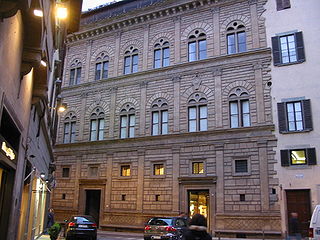
Palazzo Rucellai is a palatial fifteenth-century townhouse on the Via della Vigna Nuova in Florence, Italy. The Rucellai Palace is believed by most scholars to have been designed for Giovanni di Paolo Rucellai by Leon Battista Alberti between 1446 and 1451 and executed, at least in part, by Bernardo Rossellino. Its splendid facade was one of the first to proclaim the new ideas of Renaissance architecture based on the use of pilasters and entablatures in proportional relationship to each other. The Rucellai Palace demonstrates the impact of the antique revival but does so in a manner which is full of Renaissance originality.

Piazza della Signoria is a w-shaped square in front of the Palazzo Vecchio in Florence, Italy. It was named after the Palazzo della Signoria, also called Palazzo Vecchio. It is the main point of the origin and history of the Florentine Republic and still maintains its reputation as the political focus of the city. It is the meeting place of Florentines as well as the numerous tourists, located near Palazzo Vecchio and Piazza del Duomo and gateway to Uffizi Gallery.

Piazza dei Cavalieri is a landmark in Pisa, Italy, and the second main square of the city. This square was the political centre in medieval Pisa. After the middle of 16th century the square became the headquarters of the Order of the Knights of St. Stephen. Now it is a centre of education, being the main house of the Scuola Normale di Pisa, a higher learning institution part of the University.

Giuliano da Maiano (1432–1490) was an Italian architect, intarsia-worker, and sculptor, the elder brother of Benedetto da Maiano, with whom he often collaborated.

Gothic architecture appeared in the prosperous independent city-states of Italy in the 12th century, at the same time as it appeared in Northern Europe. In fact, unlike in other regions of Europe, it did not replace Romanesque architecture, and Italian architects were not very influenced by it. However, each city developed its own particular variations of the style. Italian architects preferred to keep the traditional construction methods established in the previous centuries; architectural solutions and technical innovations of French Gothic were seldom used. Soaring height was less important than in Northern Europe. Brick rather than stone was the most common building material, and marble was widely used for decoration. In the 15th century, when the Gothic style dominated both Northern Europe and the Italian Peninsula, Northern Italy became the birthplace of Renaissance architecture.

San Nicola is a church in Pisa, Tuscany, Italy.
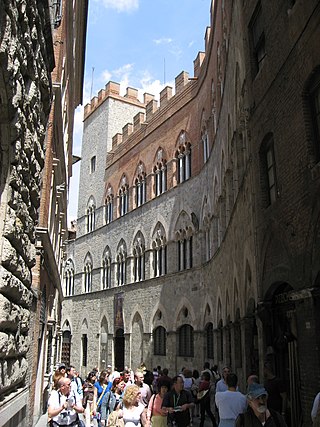
The Palazzo Chigi-Saracini is a Gothic urban palace on the Via di Città in the Terzo di Città in central Siena, Tuscany, Italy. It is the seat of the Accademia Musicale Chigiana.
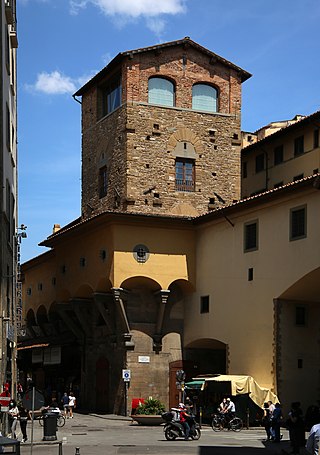
The Torre dei Mannelli is a small tower on the southeast corner of the Ponte Vecchio bridge in Florence, Italy. It is the only survivor of the four towers that once defended each corner of the bridge. In 1565, the Mannelli family refused to have it altered or demolished so that the Vasari Corridor could be built in a straight line. Instead the corridor swerved round it on brackets.
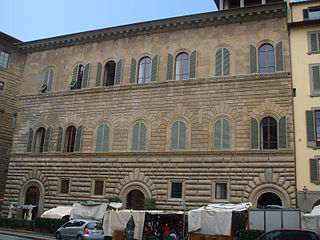
Palazzo Gondi is a palace in Florence, Italy, located a block from Piazza della Signoria. It was built in 1490 under design by Giuliano da Sangallo, who was inspired by other major works of stately buildings in the city, such as Palazzo Medici and Palazzo Strozzi. Among the elements borrowed from these earlier works are the cube-shape set around a central courtyard, the ashlar sloping on each of three floors, and the arched windows.
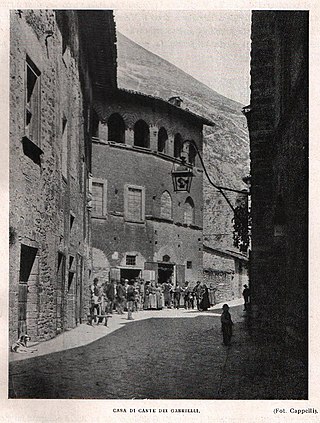
The Palazzo del Capitano del Popolo or Palazzo di Cante Gabrielli is a medieval palace in Gubbio, Italy. It is located in the San Martino's quartiere, near Porta Metauro, at the corner of via Gabrielli and via Capitano del Popolo.

Palazzo Sansedoni is a Gothic style urban palace and tower, whose concave facade is situated facing the Palazzo Pubblico across the Piazza del Campo in the political center of the city of Siena, region of Tuscany, Italy.

Palazzo Cesi-Armellini, sometimes known plainly as Palazzo Cesi, is a late Renaissance building in Rome. It is considered important for historical and architectural reasons. The palace, which should not be confused with Palazzo Cesi-Gaddi, Palazzo Muti-Cesi, or the destroyed Palazzo Cesi, placed also in Borgo near the southern Colonnade of St. Peter's square, is one of the few Renaissance buildings of the rione Borgo to have survived the destruction of the central part of the neighborhood due to the 20th century construction of Via della Conciliazione, the avenue leading to St. Peter's Basilica. Today, it is owned by the Society of the Divine Savior and part of it is used as their motherhouse.
The Palazzo Tempi, also known as Palazzo Vettori or Bargagli Petrucci, is a palace located along the Arno river at the narrow Piazza Santa Maria Soprarno 1, corner with Via de' Bardi and Costa dei Magnoli in the Oltrarno section of Florence, Tuscany, Italy. The palace is across the river from the Galleria of the Uffizi, and a block east of the Ponte Vecchio. The Via de' Bardi originates in an arch under the building.
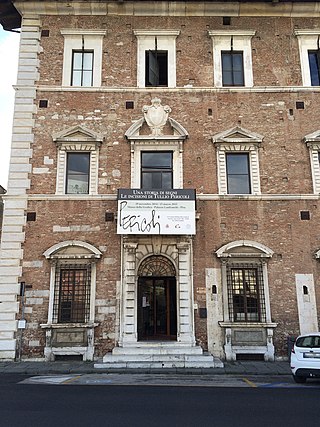
The Palazzo Lanfranchi is a palace located on Lungarno Galileo Galilei #8, in the city of Pisa, region of Tuscany, Italy.

The Palazzo degli Anziani also known as the Palazzo del Comune, della Comunitá or del Giano is a Gothic-style stone palace located in the ancient historic center of Pistoia, Tuscany, Italy. The palace served as city hall for centuries; it still belongs to the comune and now mainly houses the Museo Civico d'Arte Antica.

Borgo Vecchio, also named in the Middle Ages Via Sancta, Carriera Sancta or Carriera Martyrum, was a road in the city of Rome, Italy, important for historical and architectural reasons. The road was destroyed together with the adjacent quartier in 1936–37 due to the construction of Via della Conciliazione.